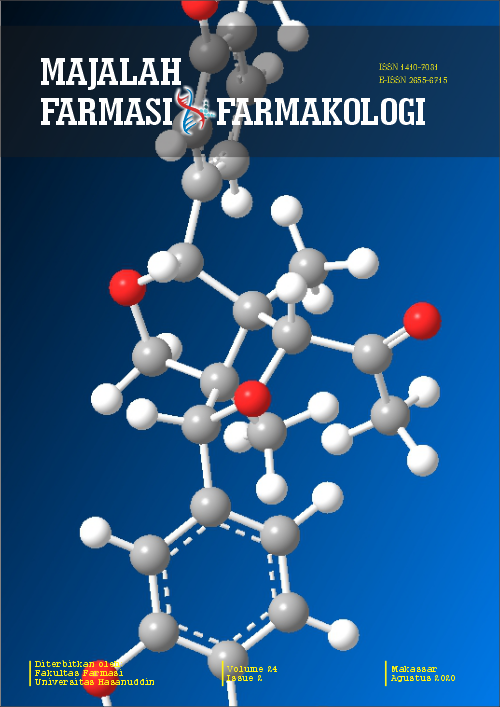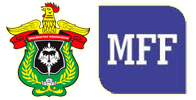UJI AKTIVITAS EKSTRAK ETANOL JAHE MERAH (Zingiber officinale Rosc var rubrum) DALAM MEMPROTEKSI DAN MEMPERBAIKI GANGGUAN FUNGSI HATI DAN GINJAL TIKUS AKIBAT INDUKSI PARASETAMOL
Abstract
Jahe merah merupakan jenis rimpang yang banyak digunakan sebagai bahan obat tradisional di Indonesia. Penelitian ini bertujuan untuk mengevaluasi efek proteksi ekstrak rimpang jahe merah (Zingiber officinale Rosc var rubrum) terhadap gangguan fungsi hati dan ginjal yang disebabkan oleh toksisitas parasetamol berdasarkan parameter SGPT, SGOT, urea dan kreatinin serum pada tikus putih. Jahe merah diekstraksi menggunakan etanol 70%. Hewan uji dibagi ke dalam 5 kelompok (n=5). Kelompok I sebagai kontrol sehat diberikan suspensi NaCMC 1%, kelompok II diberikan NaCMC 1% dan induksi parasetamol, kelompok III dan kelompok IV masing-masing diberi perlakuan ekstrak jahe merah 150 mg/kgBB dan 300 mg/kgBB dan induksi parasetamol, dan kelompok V diberikan sediaan ekstrak curcuma xanthorriza (60 mg/kgBB) dan induksi parasetamol. Perlakuan dilakukan selama 10 hari sedangkan induksi parasetamol hanya diberikan pada hari ke-4 (500 mg/kg) dan ke-5 (300 mg/kg). Sampel darah diambil pada hari ke- 6 (post induksi) dan ke-11 (post perlakuan) untuk pengukuran kadar SGOT, SGPT, kreatinin dan urea serum menggunakan alat humalyzer. Hasil penelitian menunjukkan pemberian parasetamol dosis 500mg/kg diikuti 300 mg/kgBB dapat meningkatkan nilai SGOT dan SGPT secara signifikan 24 jam setelah post induksi, namun kadar urea dan kreatinin hanya berbeda signifikan setelah hari ke-11 (post perlakuan). Pada kelompok III dan IV, pemberian ekstrak jahe merah setelah induksi parasetamol mampu menurunkan kadar SGOT, SGPT, urea dan kreatinin serum secara signifikan dibanding kelompok II (p<0.05). Penurunan biomarker hati dan ginjal pada kelompok III dan IV tidak berbeda signifikan dengan kelompok V yang diberi sediaan ekstrak curcuma yang telah digunakan secara klinik.
References
Agrawal S and Khazaeni B, Acetaminophen toxicity. In: Statpearls [internet]. 2020, StatPearls Publishing: Treasure Island (FL). //http://www.ncbi.nlm.nih.gov/books/NBK441917/.
Botta D, Shi S, White CC, Dabrowski MJ, Keener CL, Srinouanprachanh SL, et al. Acetaminophen-induced liver injury is attenuated in male glutamate-cysteine ligase transgenic mice. Journal of Biological Chemistry 2006; 281(39): 28865-28875.
Bhakuni GS, Bedi O, Bariwal J, Deshmukh R, and Kumar P. Animal models of hepatotoxicity. Inflammation Research 2016; 65(1): 13-24.
Nabavi SF, Daglia M, Moghaddam AH, Habtemariam S, and Nabavi SM. Curcumin and liver disease: From chemistry to medicine. Comprehensive Reviews in Food Science and Food Safety 2014; 13(1): 62-77.
Ha SK, Moon E, Ju MS, Kim DH, Ryu JH, Oh MS, et al. 6-shogaol, a ginger product, modulates neuroinflammation: A new approach to neuroprotection. Neuropharmacology 2012; 63(2): 211-223.
Suekawa M, Ishige A, Yuasa K, Sudo K, Aburada M, and Hosoya E. Pharmacological studies on ginger. I. Pharmacological actions of pungent constituents,(6)-gingerol and (6)-shogaol. Journal of pharmacobio-dynamics 1984; 7(11): 836-848.
Peng F, Tao Q, Wu X, Dou H, Spencer S, Mang C, et al. Cytotoxic, cytoprotective and antioxidant effects of isolated phenolic compounds from fresh ginger. Fitoterapia 2012; 83(3): 568-585.
Abdel-Azeem AS, Hegazy AM, Ibrahim KS, Farrag A-RH, and El-Sayed EM. Hepatoprotective, antioxidant, and ameliorative effects of ginger (zingiber officinale roscoe) and vitamin e in acetaminophen treated rats. Journal of dietary supplements 2013; 10(3): 195-209.
Giannini EG, Testa R, and Savarino V. Liver enzyme alteration: A guide for clinicians. Cmaj 2005; 172(3): 367-379.
Hall P and Cash J. What is the real function of the liver ‘function’tests? The Ulster medical journal 2012; 81(1): 30.
Hinson JA, Roberts DW, and James LP, Mechanisms of acetaminophen-induced liver necrosis, in Adverse drug reactions. 2010, Springer. p. 369-405.
Larson AM. Acetaminophen hepatotoxicity. Clinics in liver disease 2007; 11(3): 525-548.
Mazer M and Perrone J. Acetaminophen-induced nephrotoxicity: Pathophysiology, clinical manifestations, and management. Journal of Medical Toxicology 2008; 4(1): 2-6.
Dugasani S, Pichika MR, Nadarajah VD, Balijepalli MK, Tandra S, and Korlakunta JN. Comparative antioxidant and anti-inflammatory effects of [6]-gingerol,[8]-gingerol,[10]-gingerol and [6]-shogaol. Journal of ethnopharmacology 2010; 127(2): 515-520.
Sang S, Hong J, Wu H, Liu J, Yang CS, Pan M-H, et al. Increased growth inhibitory effects on human cancer cells and anti-inflammatory potency of shogaols from zingiber officinale relative to gingerols. Journal of agricultural and food chemistry 2009; 57(22): 10645-10650.
Mashhadi NS, Ghiasvand R, Askari G, Hariri M, Darvishi L, and Mofid MR. Anti-oxidative and anti-inflammatory effects of ginger in health and physical activity: Review of current evidence. International journal of preventive medicine 2013; 4(Suppl 1): S36.
Lü JM, Lin PH, Yao Q, and Chen C. Chemical and molecular mechanisms of antioxidants: Experimental approaches and model systems. Journal of cellular and molecular medicine 2010; 14(4): 840-860.
Downloads
Published
Issue
Section
License
The copyright to this article is transferred to Universitas Hasanuddin (UNHAS) if and when the article is accepted for publication. The undersigned hereby transfers all rights in and to the paper including without limitation all copyrights to UNHAS. The undersigned hereby represents and warrants that the paper is original and that he/she is the author of the paper, except for material that is clearly identified as to its original source, with permission notices from the copyright owners where required. The undersigned represents that he/she has the power and authority to make and execute this assignment.
We declare that:
- This paper has not been published in the same form elsewhere.
- It will not be submitted anywhere else for publication prior to acceptance/rejection by this Journal.
- A copyright permission is obtained for materials published elsewhere and which require this permission for reproduction.
Furthermore, I/We hereby transfer the unlimited rights of publication of the above-mentioned paper in whole to UNHAS The copyright transfer covers the exclusive right to reproduce and distribute the article, including reprints, translations, photographic reproductions, microform, electronic form (offline, online) or any other reproductions of similar nature.
The corresponding author signs for and accepts responsibility for releasing this material on behalf of any and all co-authors. This agreement is to be signed by at least one of the authors who have obtained the assent of the co-author(s) where applicable. After submission of this agreement signed by the corresponding author, changes of authorship or in the order of the authors listed will not be accepted.


